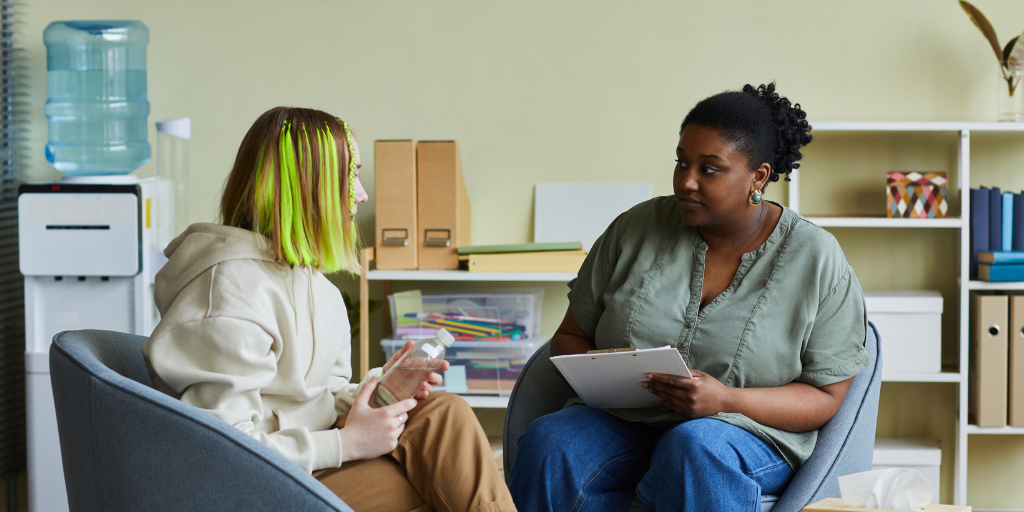
Guess Who came to therapy
‘Guess Who came to therapy’ blog article was written by Matthew Harvey and Sarah Carr, Therapeutic Specialists working in out-of-home care programs in Canberra at Australian Childhood Foundation.
One of the greatest challenges in therapy is when you and the person you are working with somehow get ‘stuck’.
Weeks can go by where you feel like you’re not really getting anywhere or talking about the right stuff. Other people involved might start asking about what you’ve achieved in session or what progress you are making.
So, what does one do when this happens?
This is where ‘agenda-less’ presence may come in to help. It might seem counterintuitive because you’re seemingly dropping the agenda, but doing so can sometimes take away the notion of forcing progress. Bonnie Badenoch speaks about the practice of ‘nonjudgmental, agenda-less presence as the foundation for safety and co-regulation’ (2018).
By letting go of the agenda we give the relationship a chance to develop more naturally or let it stay as it is; ultimately taking away pressure and promoting safety. Working from this place of safety we can help to move around places of resistance or ‘defence mechanisms’ we sometimes encounter.
An example of this recently happened in Canberra, where two therapeutic specialists were having a conversation while one was preparing for a session with a client.
One of the Specialists was looking for suggestions for engaging the young person differently due to feeling a little stuck in their progress. The other Specialist suggested they play an alternative form of the game ‘Guess Who’. In this version of Guess Who, the game changes from asking questions about physical, objective descriptions to subjective ones which can give some insight into the ‘world lens’ of the other person.
For instance, the game involves the players asking, ‘does your character play World of Warcraft?’ or ‘does your character seem introverted?’, or you might even ask, ‘does your character seem like they would have a cat?’.
The therapeutic specialist who used this game in session spoke about a breakthrough that seemed to happen while playing ‘Guess Who’ with their client. They stated that they felt the game provided an environment that allowed the young person to ‘drop their guard’ and imagine and verbalise questions about the characters on the board, even if those questions sounded silly or strange.
This, in turn, allowed the client to practice creatively generating new ideas, thinking abstractly, and using strategy, which activated their pre-frontal cortex and kept them grounded and focused.
The therapeutic specialist said it also provided a space for the young person to reveal how they subjectively viewed a collection of faces on a board and, as a parallel, helped the therapist identify how this young person might navigate their existing relationships in the ‘real world’. This young person’s early experiences meant that she perceived all men on the board as deviant and scary-looking and made comments about how they looked like they posed a risk to others, children in particular.
The session flowed into a conversation about where our assumptions can come from and if these assumptions made by the young person, that day could be connected back to earlier events in their life.
The theme of mistrust of others emerged like a buoy on the water, and it showed the therapist where to look for entrenched schemas and ideas living in the client that likely existed due to unexplored and unprocessed experiences of sexual assault and trauma as a child. This version of the game safely supported the young person to reveal the different parts of themselves that needed support and nurturing to the therapist and demonstrated ways those parts helped them survive until now.
Now, we’re not telling everyone that this form of ‘Guess Who’ will solve all roadblocks we encounter in therapy, but the idea of trying something different and agenda-less might be a good place to start for therapists and clients alike.
By trialling games or activities that offer a simulation of real-world type experience (i.e. talking about people or role-playing) or providing the opportunity to play and just explore, we allow clients to find new spaces for experimentation, reflection, and self-awareness.
On top of the child being better engaged and invested in therapy, we might also experience a little bit of laughter and silliness too, and that is integral to strengthening the therapeutic bond and healing.
References:
Badenoch, B. (2018). The heart of trauma: Healing the embodied brain in the context of relationships. W. W. Norton & Company.
Sills, F. (2010). Craniosacral biodynamics. Retrieved from http://www.craniosacral-biodynamics.org/the-inherent-treatment-plan.html
Subscribe to the Professionals Newsletter
Join our community of more than 40,000 professionals from around the world who receive our weekly newsletter containing articles. Our newsletters help connect you to our blog, research, and free resources as they are produced. We also keep you informed on training opportunities including access to experts in the field, webinars, international speaker tours, conferences and more.
